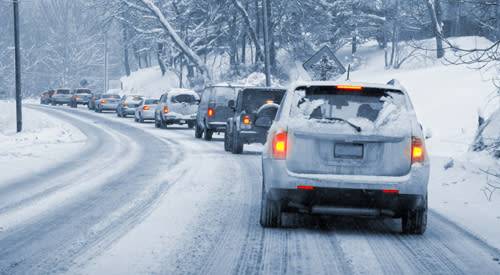Drive Safely This Winter

By Jennifer Geiger
March 5, 2015
Share

Snow, ice and cold temperatures bring out the most difficult road conditions and planning ahead could save lives. Use the National Highway Traffic Safety Administration’s check list below to make sure you’re ready.
Plan Ahead
- It might be a little late for this one, but before winter starts, it’s good to get your vehicle serviced by a mechanic to check for leaks, bad hoses or other repairs
- Have a mechanic check that your battery has sufficient voltage
- Make sure battery cable connections are secure, and have your charging system and belts inspected, too
- Make sure there is enough coolant in your car
- Completely fill your windshield washer reservoir with fluid before the first snow hits
- Spend the extra dollars for a high-quality “no-freeze” washer fluid
- Keep an extra bottle of washer fluid handy in your trunk
- Make sure your wipers are working properly with no streaking; if they are, replace them
Take Precautions
- Check the weather. Don’t hit the road if it’s too treacherous to depart
- If you absolutely need to go outside, plan to leave earlier or arrive later than usual
- Keep your gas tank at least half-full. If you get stuck in a traffic jam, you might need more fuel just to stay warm
- Pack a shovel, broom, ice scrapper, flashlight, jumper cables and warning markers or flares
- Have an abrasive material, such as kitty litter or sand, ready to help with traction
- Have a blanket, cell phone, some water, food and any necessary medicine (for longer trips through rural areas) On the Road
- Always wear your seat belt (This really should go without saying)
- Wear winter outerwear, and make sure your passengers, especially children, are bundled up for the snowy conditions
- Do not text or engage in distracting activities while driving
Stranded in the Cold
- Stay in your car, and don’t overexert yourself
- Make yourself easy to find by keeping your interior light turned on and removing the cover from the dome light, if possible
- Put bright markers or reflective material on your antenna or windows
- Avoid carbon monoxide buildup by avoiding long stretches of idling with the windows up. If you have to keep the car running, make sure the exhaust pipe is clear of snow, and keep the engine running just long enough to stay warm
Related
How to Drive Safely on Snow and Ice
Winter Brings on ‘Peephole’ Driving
More Safety News on Cars.com

News Editor
Jennifer Geiger
News Editor Jennifer Geiger joined the automotive industry in 2003, much to the delight of her Corvette-obsessed dad. Jennifer is an expert reviewer, certified car-seat technician and mom of three. She wears a lot of hats — many of them while driving a minivan.
Featured stories


By Brian Normile
Road Test Editor

By Jennifer Geiger
December 15, 2025

By Lawrence Hodge
December 15, 2025
